 |
||
|
||
| ||
By Grigory
Kinyo is a rather large OEM manufacturer of multimedia acoustic systems which delivers its products to various brand companies (for detailed information look here). The R-565 and D-565 models we are going to talk about have been released a short time ago. These two sets were combined in a single review since their speakers and amplifying parts are absolutely identical. The only difference is lack of a DD5.1 decoder in the R-565. AppearanceThe boxes the sets are packed in are nice and massive; each weighs 15 kg. According to the information on the package and on the site, the sets can be connected to:
You see that they don't mention a modern home computer equipped with a DVD-ROM drive and a sound card with a digital-out (or multichannel analog-out). But it would be strange to connect a $200 set to a good DVD-player priced at $400. In our opinion, the R-565 and D-565 should be used as a multimedia computer acoustic system. AccessoriesThe R-565 and D-565 sets include:
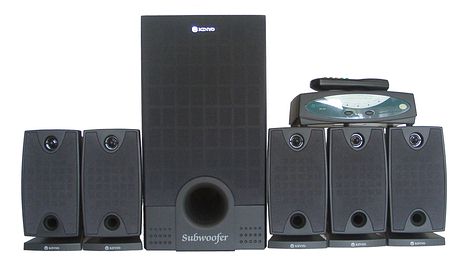 The dual-band satellites seem to have rather good mid-range dynamic heads. The case of the subwoofer is wooden. A phase inverter and a diffuser of the low-frequency speaker located on the front panel are quite large. Both sets (!) are supplied with remote controls. Well, the R-565 and D-565 look promising. 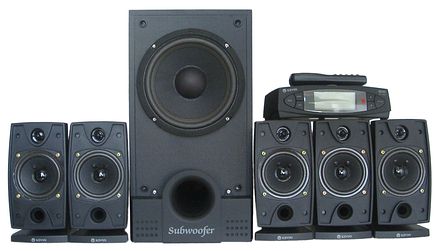 SatellitesThe cases of satellites are, unfortunately, plastic. But the experience shows that the performance depends not only on the material the case is made of, but also on a great deal of other factors. At the front you will can a hole for a phase inverter which seems to have a decorative function. The supports for the speakers do not have rubbery legs, and if you draw a satellite's cable it will start sliding along the desk and creaking. If you look attentively at the mid-range dynamic heads you will notice a very soft rubber suspension bracket of the diffusers. A twitter and a mid-range speaker are paralleled. The high-frequency head uses a 3.3 mF electrolytic capacitor as a filter. The universal support can be connected to a speaker in a vertical or horizontal position. At the bottom it has a mount for floorstanders which are, though, not supplied with the systems. The support is connected with a speaker with only one screw, but the connection is very strong at the expense of grooves in the speaker. 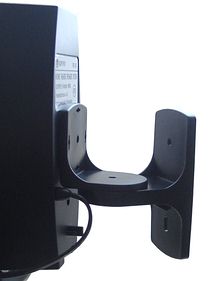 The fasteners are designed to mount the satellites onto sheer surfaces, for example, walls. The speaker can be installed both in parallel and in vertical positions relative to the surface. The range within which you can change an angle of direction is 150 degrees. In the box you will find 5 supports and 4 fasteners with 16 screws, 13 bolts and 8 washers. SubwooferA box with a phase inverter is in charge of the acoustic functions. The diffuser of the dynamic head is located on the front panel and is covered with a protecting mesh. The panels of the case are 12 mm wide. Inside the sub is divided into two parts with a horizontal partition, which at the same time acts as a stiffening rib. The parts are connected with a vertical tube 2 cm in diameter located near the phase inverter's end. In the upper part you will find a power supply unit, an amplifier and a dynamic head. The board with an amplifier are attached to the rear panel, while a power supply unit is located on the partition. In the lower part you will find a phase inverter tube 234 mm long. Its output 51 mm in diameter is located on the front panel. The rear side of the sub contains:
Remote controlThe remote controls of the R-565 and D-565 look differently, but both are quite small and convenient in use. Buttons are located quite far from each other and have different colors according to their functions. The device is powered by 2 1.5V AAA batteries. DR-30A remote control (R-565)The Power button will help you to enable the Stand by mode. When you are in the stereo mode the Surround button will allow you to add rear speakers to the sub, central and front speakers. The rear speakers double front speakers and play with some delay. The Mute turns on/off the volume. The Input switches input modes (either 5.1 or usual stereo). The Reset will make all settings initial. The "+" and "-" will help you turn up/down the volume. The subwoofer and the front speaker have their won regulators. The remote control will help you adjust the balance both between the left and right channels and between the front and rear ones. DR-20 remote control (D-565)The Power button will help you to enable the Stand by mode. The Mute turns on/off the volume. The Input switch decoder input modes (optical, coaxial, analog). The Reset will make all settings initial. When the stereo mode is on the Surround button allows you to add rear and central speakers to the sub and ones. It has three volume levels of the channels: Game (front speakers play louder), Music (the volume levels of all chanels are balanced) and Theater (the difference from the previous mode is unnoticeable). The Pro Logic CFG button switches operating modes (Pro Logic or usual Stereo). The Test one applies a noise signal to each speaker in turn. The Listening mode switches volume modes: Night - quiet, Standard - average and Maximum - loud. The Balance will help you adjust the volume for each channel relative to the general volume level. The Delay button will set a delay for central, front and rear channels separately. The distance from a speaker to a listener is measured in feet. The below green buttons adjust the last two modes (Balance, Delay) and the general volume level. But where is a button for Dolby Digital 5.1? Here the decoder detects automatically the DD5.1 format. C-20 decoder (D-565) The decoding unit is rather small and stands on 4 soft rubbery pads. The power button is located on top. The front panel contains different buttons doubled in the remote control and a light-emitting diode display. Besides, there is an LCD which displays a current status of the decoder. I think that it is very important to have all channels enabled in one or another mode displayed on the screen. For example, if you adjust the volume of the channels in the Dolby Digital 5.1 it is useful when the display shows the number of enabled channels and their volume.  The rear panel of the decoder contains:
The decoder uses an AK4526AVQ chip. Let's take a look at its characteristics
The characteristics are excellent for such a cheap decoder! Commutation and remote control unit RB-6A (R-565)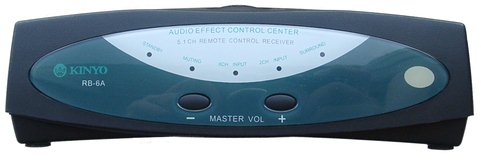 The RB-6A unit and the C-20 decoder look very similar: the remote control stands on rubbery pads, a power button is located on top. But the front panel contains only mode indicators (Stand by, Mute, Surround, 6th and 2th channel) and buttons for general volume control. 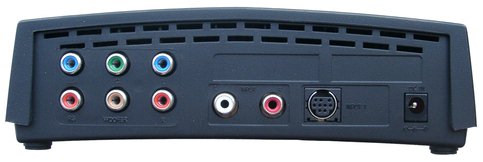 The rear panel contains:
Characteristics of the setSatellite
Subwoofer
Note that these characteristic do not include the bandpass flatness. Power supply unit: 230 V 50 Hz (12.5V - 2,800mA, 11.5V - 1,000mA). Amplifying partWe opened a rear lid of the subwoofer to find out the marking of the chips. They were, however, hidden behind a heap of various capacitors so that it was impossible to photograph them. If you look attentively at the amplifier's board you will notice that soldering is not tidy. The amplifying track contains TDA7294 and TA8229K chips. Let's take a gander at their specs. TDA7294This chip is used in the amplifying track of the subwoofer. The power in RMS totals 70 W at THD = 0.5% and any load resistance (4 Ohm, 6 Ohm, 8 Ohm). THD doesn't exceed 0.1% at the power up to 50 W, +/-27 V supply voltage and 4 Ohm resistance in the frequency range from 20 Hz to 20 kHz. Well, the chip has rather good characteristics. And this accounts for quite good sounding of the subwoofer. TA8229KThere are three such chips; they are used to amplify the other five channels. 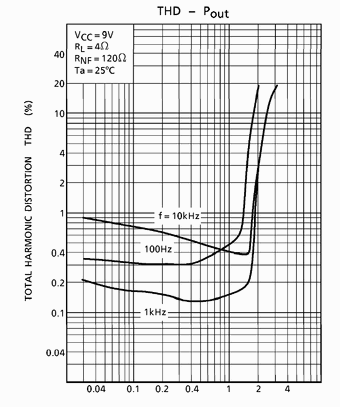 If you look at the graph given in the specification, you will see that the THD is low only at the power up to 1.5 W (RMS). This power value corresponds to an average volume level for the satellites. Well, these acoustic sets from Kinyo can be recommended only for watching movies and playing games for one person. These systems are not the best choice for a home theater. ConnectionThe connection wasn't flawless. We had to purchase additional cables with adapters in order to connect the R-565 to the analog-outs of a 6-channel sound card. The system is supplied only with a mini-DIN cable for 6 RCA connectors, while the sound card has mini-jack ones. That is why we had to fetch 3 cables "minijack to stereo-RCA" and "stereo-RCA (female) to stereo-RCA (female)" adapters. And what about a cable with mini-DIN connectors? There are still some 6-channel cards, for example, Genius Sound Maker Live 5.1 or ABIT AU10, which have mini-DIN output. So, why not to use it? So, we tried to connect the R-565 this way. When we started the test for 6 channels it turned out that the rear left speaker played a front right channel, while the front right speaker didn't produce anything... Computer configuration
Connection of the D-565 in a digital mode through the stereo-in didn't cause any problems (in case of both sets). The cables of the front and central speakers are 3 m long, while the rear speakers have 8 m ones. Connectors of different colors make the process of connection of the speakers to the amplifier faster and easier. When you adjusting parameters the speakers of both sets produce unpleasant clicks. Audio testsTest compositions: CD-DA: Dance of the Knights from Romeo and Juliet by Prokofiev. MP3: modern electronic music and compositions of popular singers. The symphonic compositions are played tolerably, but there is a lack of high frequencies, mid ones have some kind of plastic sound; the sound the subwoofer produces is non-uniform, booming and blurry. In case of the popular music there is the same lack of highs. The mids are delivered rather good but too quiet. As for the subwoofer, the volume reserve is large enough. The sub sounded rather soft and trustworthy. The volume is enough for a room of an average size. In closing it should be noted that both R-565 and D-565 deliver very good lows, while highs and lower mids are to be improved yet. Game testsIn the 3D shooters (Q3, UT, Serious Sam, Solder of Fortune) these systems make rather good impression. The subwoofer worked properly, but at too high volume level its panels brought into odd harmonics (so did the speakers). The stereo panorama and the 3D sound were delivered fairly well. In the quests and strategies (which usually have richer samples) the R-565 and D-565 played not worse than in the 3D shooters. But the volume of different frequency bands is distributed non-uniformly. So, the lower mid range sounds almost unnoticeably against the general background. Tests in DVDTo estimate the quality of reproduction of sound tracks from DVD movies we watched different DVD trailers. But why only trailers? The matter is that DVD trailers recorded in the Dolby Digital 5.1 format have the highest degree of concentration of sound effects. Undoubtedly, both the R-565 and D-565 performed excellently here. All talks were heard perfectly well. But if I were a developer, I would add one more mid-range head for the central speaker. Since you can adjust the volume of the channels with a remote control, you always can get the best sound from the system wherever you may be. I don't recommend you to place the rear speakers too far, since in this case you will have to turn them up considerably thus making the distortions larger. The subwoofer plays good, but it, sadly, is "accompanied" by its panels at a high volume level and has a blurred timbre. Recommendations
ConclusionThe R-565 and D-565 systems are something between 5.1 sets of plastic sound imitators and active 5.1 acoustic systems for a computer. It is interesting that excellent dynamic heads and codecs (in the D-565) are paid much more attention to than the satellites. Highs
Lows
Write a comment below. No registration needed!
|
Platform · Video · Multimedia · Mobile · Other || About us & Privacy policy · Twitter · Facebook Copyright © Byrds Research & Publishing, Ltd., 1997–2011. All rights reserved. |